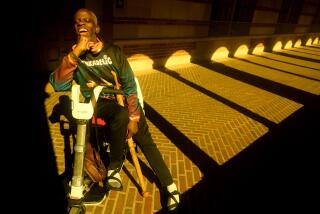A Child’s Lesson in Care-Giving : Disability: Those who protest putting disabled kids in regular classrooms fail to see how much the ‘normal’ kids learn from it.
- Share via
When my daughter Jessica was 4 years old, she attended nursery school with a little boy who was disabled. Each morning, she would cry because the boy--we’ll call him Johnny--frightened her. Despite our efforts to reassure her and explain Johnny’s disability, it was a struggle to get her to go to school each day. Once there, it was even more of a struggle to persuade her not to run off in tears anytime Johnny came near her.
Last summer, she visited a good friend of our family who took Jessica to lunch at a neighbor’s house. The neighbor had a severely disabled daughter who used a wheelchair and uttered incomprehensible sounds. Jessica was again in turmoil. After a few minutes, she asked our friend if she could talk with her privately. Away from the disabled young woman, she burst into tears and confessed how frightened and sad she felt. Could she go into the garden and draw until after lunch, she begged?
It’s now one year later--and Jessica is 7. She is no longer afraid of all sick and disabled people. She hasn’t grown out of her fears; she has learned her way out of them under an “inclusion” program at her public school in Arlington, Mass, where a child born with muscular dystrophy was a member of her first-grade class.
In both educational circles and the press, there’s been a lot of debate about the virtues of including disabled children in America’s classrooms. Critics cite the expense of hiring assistant teachers to help these disabled children. They argue that the presence of children with severe disabilities has a negative impact on the “normal” children in the classroom. The subtext is that the disabled will learn but the “normal” kids won’t. Supporters counter by focusing on the benefits that inclusion brings to the disabled children around whose social and educational needs these programs have been designed.
As a parent, I want to argue in favor of inclusion, not only because of the help it gives to disabled students but because of the educational and social value it has for the rest of the students, like my 7-year-old daughter.
I spent the past year watching all the things that Jessica and her classmates learned from their classmate Paula and I am deeply impressed. As Jessica explains to anyone who will listen, Paula may not be able to walk or even to move anything but her chin, but she certainly can listen, talk and learn. Jessie is amazed at how skillfully Paula navigates through the school in a 200-pound wheelchair that she guides by pushing her chin against a rubber cup. In class, a teacher’s assistant works with her.
Paula takes part in all the class activities and even goes to gym. The day I came to visit the classroom, my daughter and several other students held up Paula’s arms when the children were playing “Simon Says.” When it was math time, teams of three kids were asked to solve problems with movable objects, like beads, or beans, or pennies. Paula and Jessica were on a team together and they helped each other.
Jessica has been to Paula’s house to play and has marveled at the elevator chair that takes her up the stairs and at how Paula is able to play by herself and with others. One afternoon, while recounting the “stuff” she did that day, my daughter confided that Paula had had an accident and wet her pants in class. The tone of voice caught me totally off guard. As if the class had won a competition or passed the most exhausting series of exams, she explained that not one child laughed or made fun of her.
Jessica is not only comfortable with the details of Paula’s illness, she is now well versed in the technology necessary to help Paula negotiate life. While Paula has been learning, so has my daughter--about medicine, technology and about caring for other human beings. To me, the lessons about care-giving are the most important. I have long wondered where, in a society that fears illness and disability, vulnerability and dependence, kids can learn to tolerate infirmity and to appreciate interdependence. In my daughter’s case I am thankful to say that she and her classmates are mastering these lessons in elementary school.
The other day, Jessica and I were talking about Paula. “You know, Mom,” she said, “Paula changed that feeling in me of being scared of people who are disabled. I don’t cry when I’m next to Paula or want to run away. I just keep playing with her because she’s one of my best friends. Paula changed my life.”






